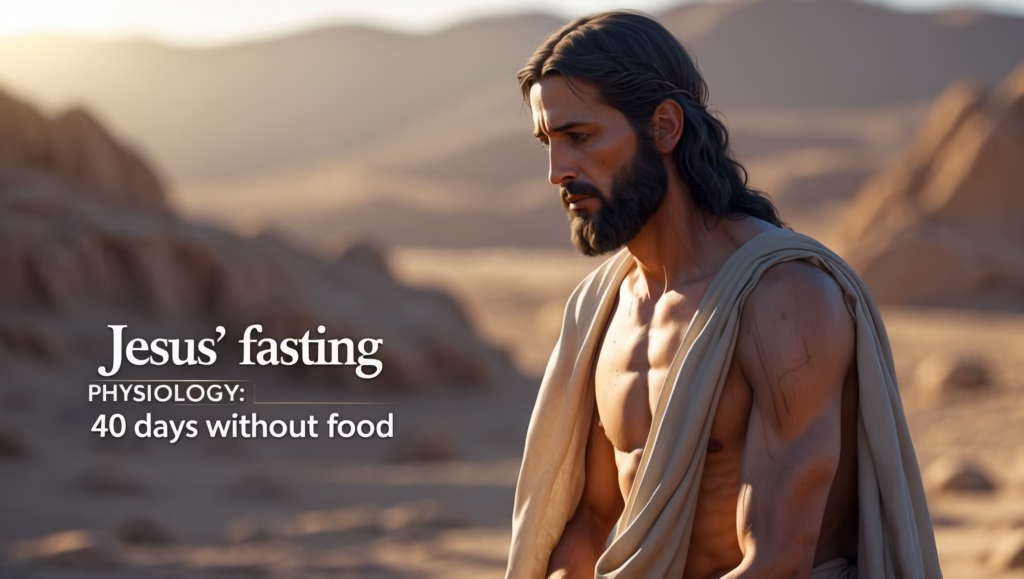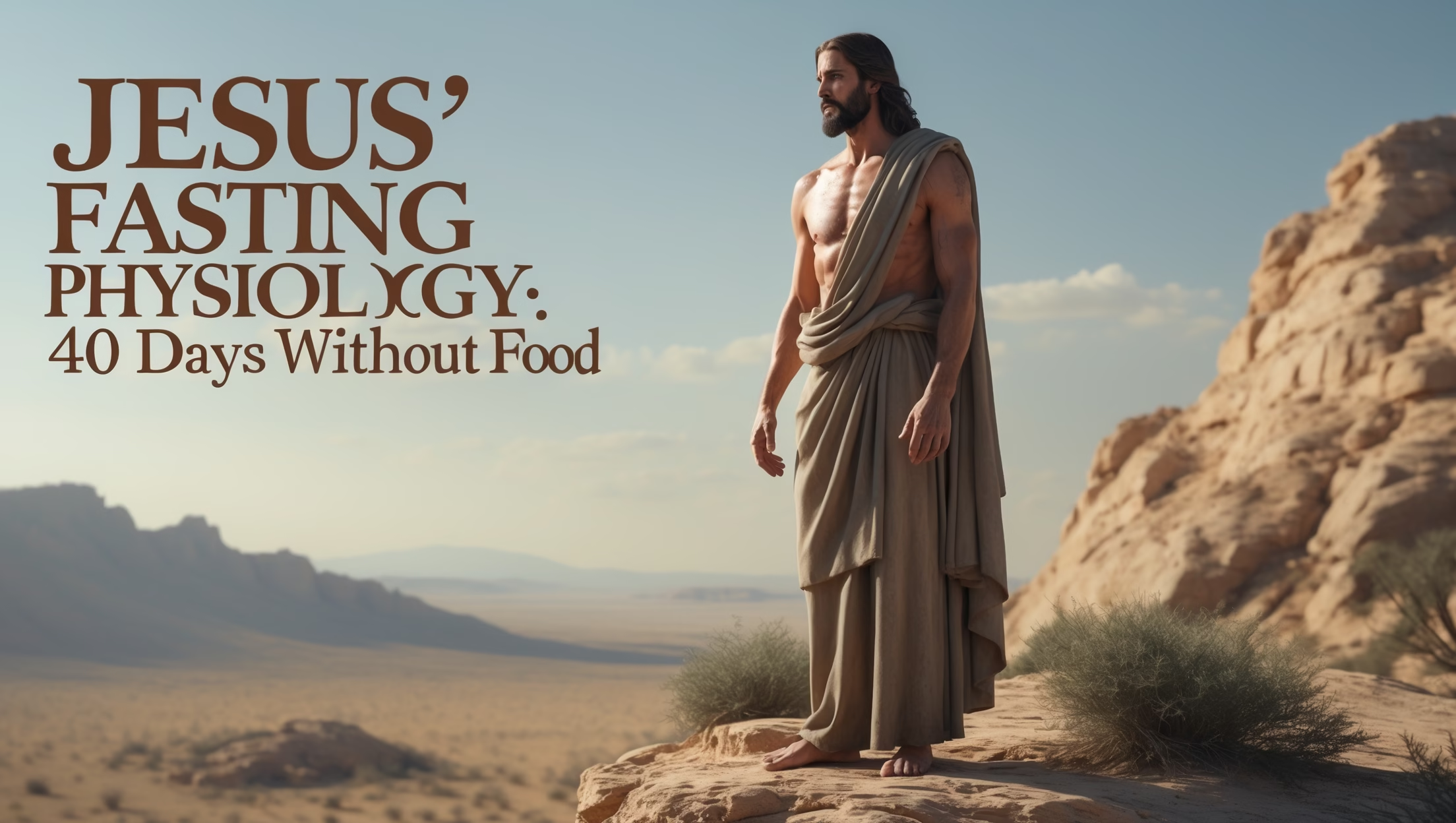The Gospel accounts of Jesus’ 40-day fast in the wilderness (Matthew 4:1–11, Luke 4:1–13) have long captivated theologians, spiritual seekers, and skeptics alike. While faith emphasizes the miraculous, modern medical science allows us to explore what prolonged fasting actually does to the human body. By combining endocrinology, nutrition science, and historical context, we can better understand the physiological challenges Jesus would have faced—and why His survival would have required extraordinary intervention.

Metabolic Stages of Prolonged Fasting
Fasting triggers predictable metabolic shifts as the body adapts to extreme caloric deprivation. Researchers highlight several key stages relevant to Jesus’ 40-day experience:
- Days 1–3: Glycogen Depletion
- The liver and muscles consume stored glycogen to maintain blood glucose.
- Symptoms: fatigue, irritability, mood swings, and heightened focus, which may explain Matthew 4:3’s reference to Satan testing Jesus’ mental and emotional state.
- Physiological Note: Glycogen provides less than a day’s worth of energy for intense activity, forcing the body to begin shifting fuel sources rapidly.
- The liver and muscles consume stored glycogen to maintain blood glucose.
- Week 2: Ketosis and Mental Clarity
- Fat stores convert into ketone bodies to fuel the brain and other organs.
- Spiritual Interpretation: Many mystics report enhanced cognitive clarity and spiritual insight during ketosis, potentially mirroring Jesus’ sharpened focus and discernment in confronting temptation.
- Clinical Observations: Increased alertness and reduced appetite are common among fasting individuals in this stage.
- Fat stores convert into ketone bodies to fuel the brain and other organs.
- Weeks 3–4: Protein Catabolism and Organ Adaptation
- The body begins breaking down skeletal muscle and non-essential proteins to sustain vital organ function.
- Effects: Muscle wasting, weakness, hypotension, and organ shrinkage—though the brain is largely preserved.
- Risk Factors: Without hydration or micronutrient support, serious organ damage occurs rapidly.
- The body begins breaking down skeletal muscle and non-essential proteins to sustain vital organ function.
- Day 40: Near-Fatal Threshold
- By this stage, muscle mass is critically diminished, electrolytes are imbalanced, and cardiac stress peaks.
- Medical Perspective: Survival beyond 40 days without food—and often water—is virtually impossible without divine intervention.
- Theological Implication: Jesus’ endurance demonstrates a supernatural preservation of life, highlighting His unique embodiment of human and divine capacities.
- By this stage, muscle mass is critically diminished, electrolytes are imbalanced, and cardiac stress peaks.
Psychological and Spiritual Dimensions
Fasting affects not only the body but also cognition and emotional processing:
- Heightened stress resilience and discipline emerge as cortisol spikes during early fasting stages.
- Spiritual experiences are frequently reported by individuals in prolonged fasts, including visions, profound insights, and altered perception of time—paralleling the Gospels’ depiction of Jesus confronting temptation and achieving spiritual clarity.
- Solitude and deprivation may amplify the perception of divine presence, reinforcing the transformative nature of the wilderness experience.
Historical and Cultural Context
In first-century Judea, fasting was a recognized ascetic practice among prophets and sects, though none reportedly approached 40 continuous days. Jesus’ fast aligns with:
- Prophetic Tradition: Moses fasted 40 days on Mount Sinai (Exodus 34:28).
- Spiritual Preparation: Extended fasting was associated with receiving divine revelation and demonstrating obedience.
- Wilderness Setting: The isolated desert of Judea, with limited shelter and extreme temperatures, would exacerbate physiological stress.
Modern Medical Comparisons
Contemporary fasting experiments, including controlled starvation studies, reinforce the exceptional nature of Jesus’ experience:
- Most healthy adults survive 30–35 days with careful hydration; 40 days is a near-lethal duration.
- Keto-adapted endurance athletes experience some cognitive benefits during prolonged fasting but still suffer irreversible tissue loss without intervention.
- Hydration is critical; complete water deprivation leads to death within days—Gospel accounts imply access to water, aligning with plausibility constraints.
Why This Matters
Examining Jesus’ fasting through a scientific lens provides:
- Physiological Insight: Understanding the extreme physical demands emphasizes the radical nature of His discipline.
- Theological Depth: Survival and victory over temptation highlight the interplay of human vulnerability and divine empowerment.
- Practical Application: Modern believers practicing intermittent or extended fasting can appreciate historical precedence and health considerations.










